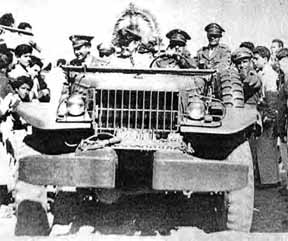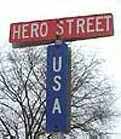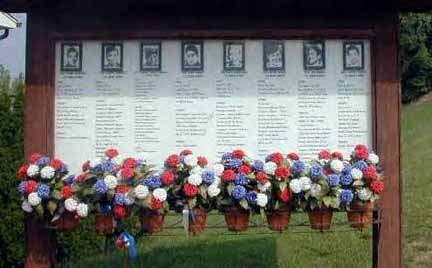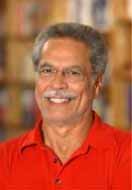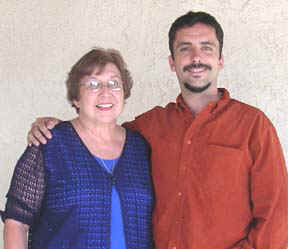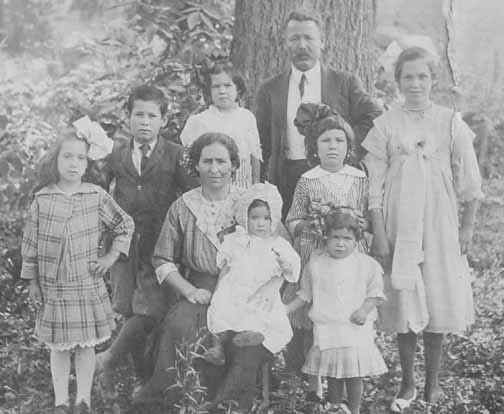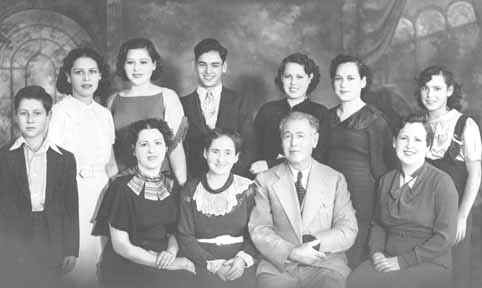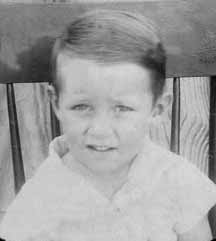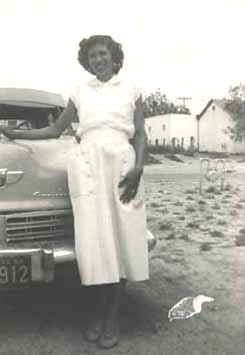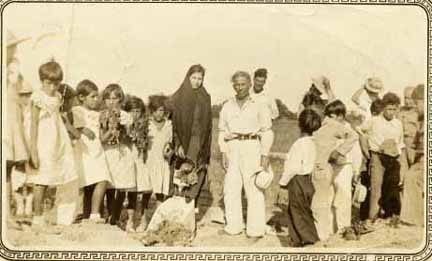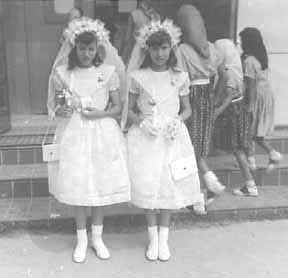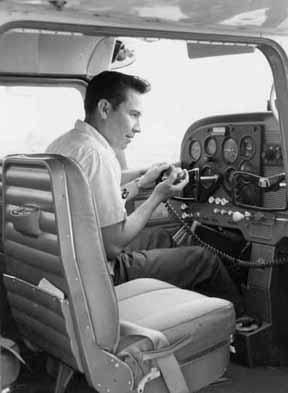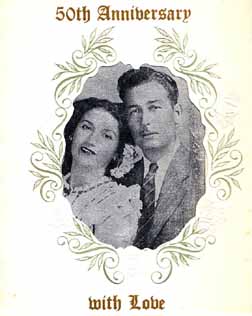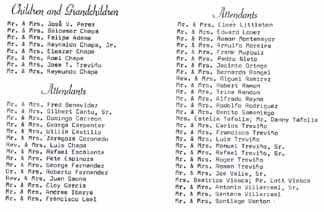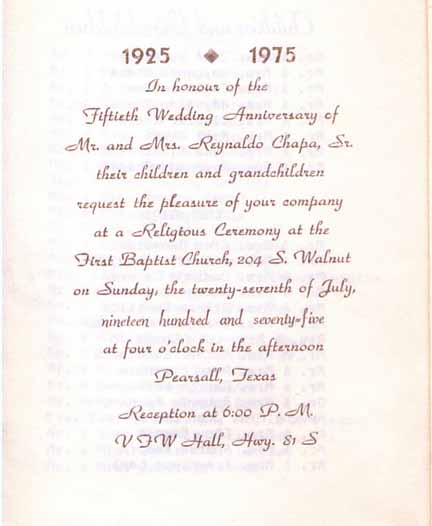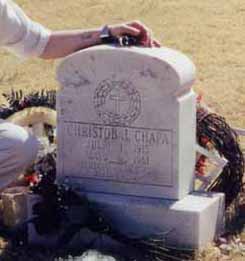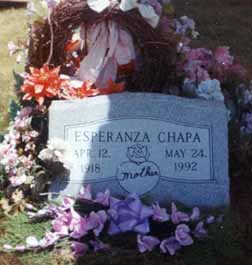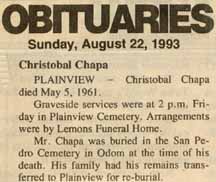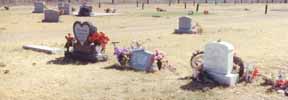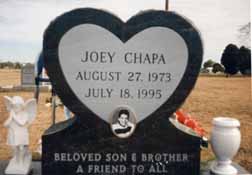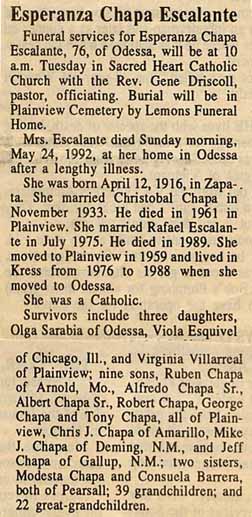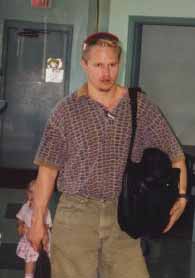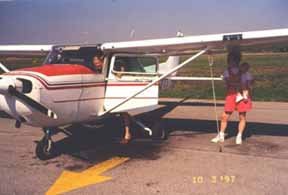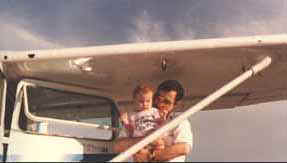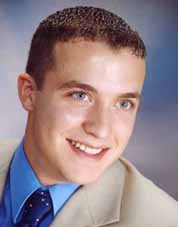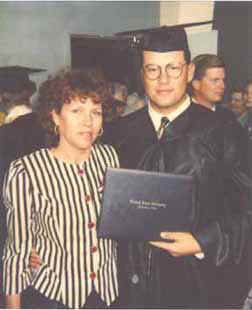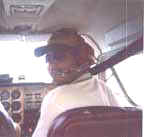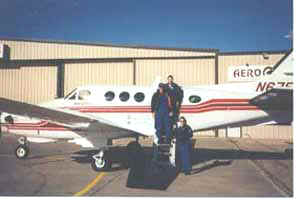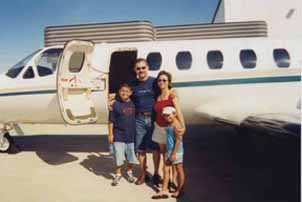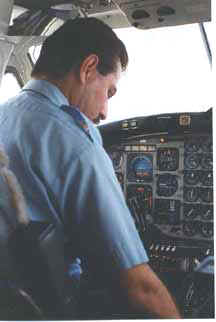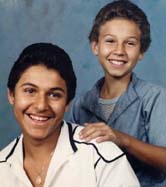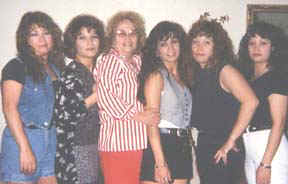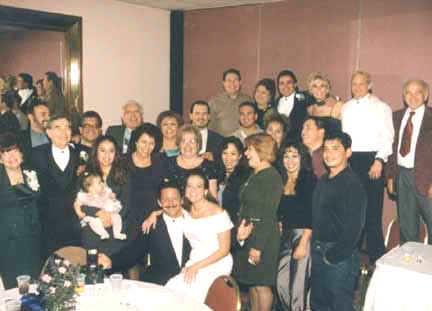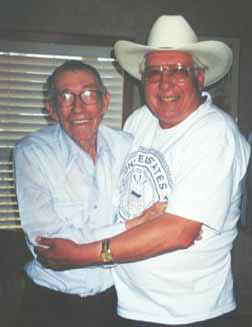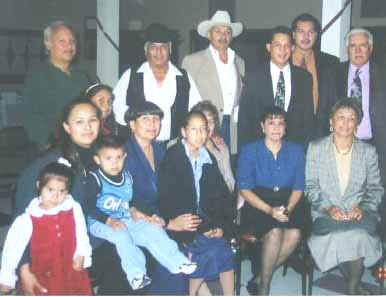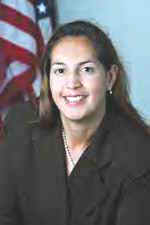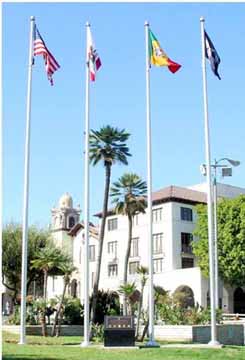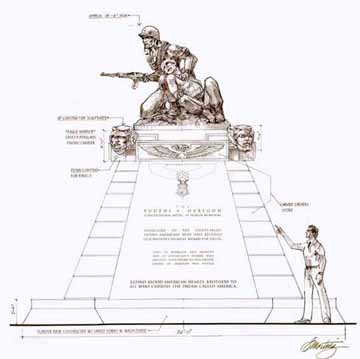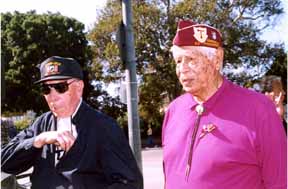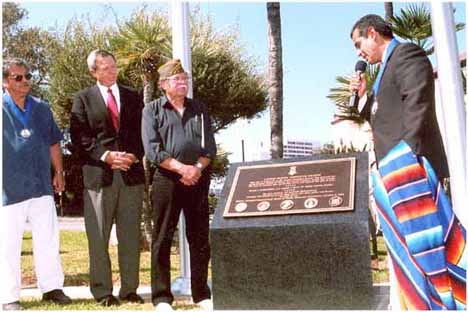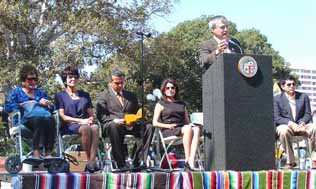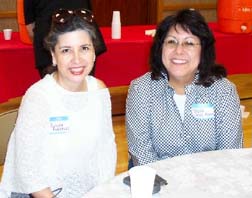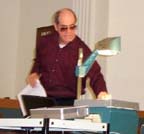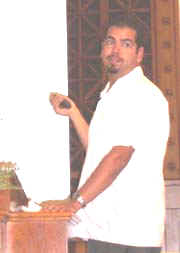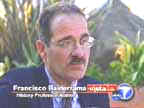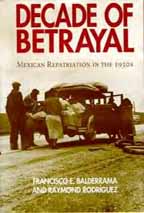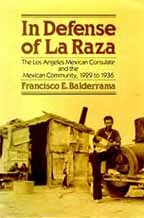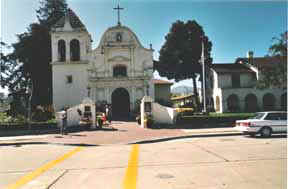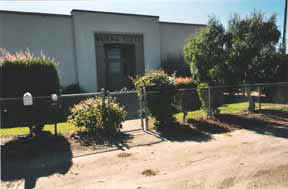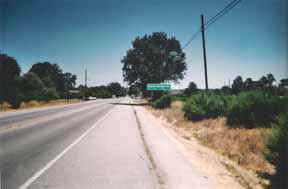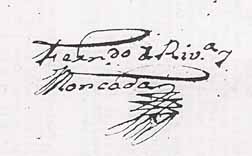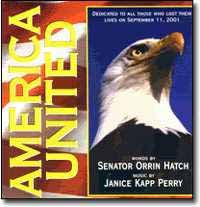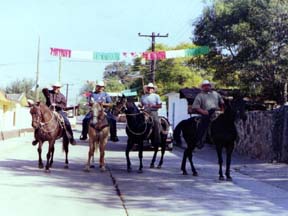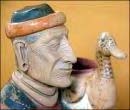MARIA-JUANA-DE-LA-EXPECTACION8 CANALES-ROSILLO (JOSE-ANTONIO-NEPOMUSENO7
CANALES-TREVINO, JOSE-JOAQUIN6 CANALES-GONZALEZ-HIDALGO, JOSE-SALVADOR5
CANALES-BENAVIDES, BLAS4 CANALES-MONTEMAYOR, JUAN3 CANALES, JOSE2,
ANTONIO1) was born December 28, 1809 in Sagrario Metropolitano,
Monterrey, Nuevo Leon, Mexico. She married MIGUEL DE SADA May 26, 1832
in Sagrario Metro, Monterrey, Nuevo Leon, Mexico.Children of
MARIA-JUANA-DE-LA-EXPECTACION CANALES-ROSILLO and MIGUEL DE SADA are:i.
JOSE-MARIA-DE-JESUS-MARCOS9 DE SADA-CANALES, b. April 25, 1836, Sagrario
Metropolitano, Monterrey, Nuevo Leon, Mexico.
100. ii. ANTONIO DE SADA-CANALES, b. 1838.
iii. MARIA-ANA-VICTORIA DE SADA-CANALES, b. December 23, 1839,
Sagrario Metropolitano, Monterrey, Nuevo Leon, Mexico.
iv. MARIA-ANTONIA-MACRIMINA DE SADA-CANALES, b. August 22, 1844,
Sagrario Metropolitano, Monterrey, Nuevo Leon, Mexico.
70.
JOSE-MANUEL-FELIPE8 CANALES-SOBREVILLA (JOSEPH-MARIANO-DIONISIO7
CANALES-FLORES, JOSEPH-IGNACIO-HERMAN6 CANALES-GONZALEZ, JOSE-SALVADOR5
CANALES-BENAVIDES, BLAS4 CANALES-MONTEMAYOR, JUAN3 CANALES, JOSE2,
ANTONIO1) was born February 06, 1806 in San Pedro, Boca de Leones, Nuevo
Leon, Mexico. He married MARIA-FELICIANA TAMEZ November 26, 1825 in San
Juan Bautista, Lampazos de Naranjo, Nuevo Leon, Mexico.Children of
JOSE-MANUEL-FELIPE CANALES-SOBREVILLA and MARIA-FELICIANA TAMEZ are:
i. JOSE-EUTIQUIO9 CANALES-TAMEZ, b. September 10, 1826, San Juan
Bautista, Lampazos de Naranjo, Nuevo Leon, Mexico.
ii. MARIA-INOCENCIA CANALES-TAMEZ, b. January 28, 1829, San Juan
Bautista, Lampazos de Naranjo, Nuevo Leon, Mexico.
iii. MARIA-CLEMENCIA CANALES-TAMEZ, b. December 15, 1830, San Juan
Bautista, Lampazos de Naranjo, Nuevo Leon, Mexico.
iv. FILUCRECIO CANALES-TAMEZ, b. December 14, 1832, San Juan
Bautista, Lampazos de Naranjo, Nuevo Leon, Mexico.
71. PETRA-RITA8
CANALES-GONZALEZ (ESTEBAN7 CANALES-GARCIA, JOSE-JUAN-ANTONIO6
CANALES-GONZALEZ, JOSE-SALVADOR5 CANALES-BENAVIDES, BLAS4 CANALES-MONTEMAYOR,
JUAN3 CANALES, JOSE2, ANTONIO1) was born May 25, 1810. She married
GREGORIO SAENZ-SALINAS June 17, 1828, son of JOSE-DE-JESUS
SAENZ-GONZALEZ and MARIA-DEL-REFUGIO SALINAS-RAMOS.Children of
PETRA-RITA CANALES-GONZALEZ and GREGORIO SAENZ-SALINAS are:
i. EXCELSA-DEL-REFUGIO9 SAENZ-CANALES, m. JOSE-MARIA DEL
BOSQUE-ESCOBAR.
ii. MARIA-ANTONIA SAENZ-CANALES, m. ROBERT MARGO.
iii. CAMILO SAENZ-CANALES, m. MARIA-DE-JESUS DE-LA-PENA.
iv. FLORENTINA-DEL-REFUGIO SAENZ-CANALES.
v. CLARA SAENZ-CANALES.
vi. NESTOR-DE-LA-ENCARNACION SAENZ-CANALES.
vii. EPIFANIO SAENZ-CANALES.
viii. REGUGIA SAENZ-CANALES.
72.
MARIA-ANTONIA8 VIDAURRI-CANALES (MARIA-LEONOR7 CANALES-GARCIA,
JOSE-JUAN-ANTONIO6 CANALES-GONZALEZ, JOSE-SALVADOR5 CANALES-BENAVIDES,
BLAS4 CANALES-MONTEMAYOR, JUAN3 CANALES, JOSE2, ANTONIO1) was born May
18, 1797 in Mier, Tamaulipas, Mexico. She married JOSE-HIPOLITO
DE-LA-PENA-GARCIA May 14, 1816 in Mier, Tamailipas, Mexico, son of
JOSEPH-ANTONIO DE-LA-PENA-LOPEZ and MARIA-PETRA GARCIA-DE-LA-BARRERA. He
was born 1794.Child of MARIA-ANTONIA VIDAURRI-CANALES and JOSE-HIPOLITO
DE-LA-PENA-GARCIA is:
i. MARIA-DE-LA-ENCARNACION9 DE-LA-PENA-VIDAURRI, b. September 12,
1817, Mier, Tamaulipas, Mexico; d. August 20, 1833, Mier, Tamaulipas,
Mexico.
73.
JOSE-LAUREANO8 VIDAURRI-CANALES (MARIA-LEONOR7 CANALES-GARCIA,
JOSE-JUAN-ANTONIO6 CANALES-GONZALEZ, JOSE-SALVADOR5 CANALES-BENAVIDES,
BLAS4 CANALES-MONTEMAYOR, JUAN3 CANALES, JOSE2, ANTONIO1) was born July
06, 1818 in Mier, Tamaulipas, Mexico, and died in Rancho San Jose de
Corralitos, Zapata County, Texas. He married TRINIDAD CUELLAR-BENAVIDES
May 23, 1852 in San Agustin, Laredo, Webb County, Texas, daughter of
SALVADOR CUELLAR-SANCHEZ and MARIA BENAVIDES-GUZMAN. She was born 1835
in Laredo, Webb County, Texas.Notes for JOSE-LAUREANO VIDAURRI-CANALES:
The 1860 Census listed his age as 40. "Fundadores de
Laredo" indicated he was born about 1832, and listed his occupation
as "stockfarmer". Laureano was a native of Ciudad Mier and
resided at San Jose De Corralitos Ranch, Zapata, Texas
On the 1880 USA census he is listed as 62 years of age. San Jose De
Corralitos, Zapata, Texas
Children of JOSE-LAUREANO VIDAURRI-CANALES and TRINIDAD
CUELLAR-BENAVIDES are:
i. BACILIO9 VIDAURRI-CUELLAR.
101. ii. ANTONIA VIDAURRI-CUELLAR, b. 1857; d. Falfurrias, Brooks
County, Texas.
iii. LEONOR VIDAURRI-CUELLAR, b. 1860.
iv. JESUS-MARIA VIDAURRI-CUELLAR, m. JULIANA RAMIREZ, April 18, 1910,
Laredo, Webb County, Texas.
v. ALEJANDRO VIDAURRI-CUELLAR, b. 1862.
vi. JUAN VIDAURRI-CUELLAR, b. 1865.
74. MICHAELA8
CANALES-YSAGUIRRE (JUAN-FRANCISCO-JAVIER7 CANALES-DE-LA-GARZA,
JOSE-ANTONIO-BLAS6 CANALES-ANZALDUA, JOSE-BLAS5 CANALES-BENAVIDAS, BLAS4
CANALES-MONTEMAYOR, JUAN3 CANALES, JOSE2, ANTONIO1) was born 1812. She
married JOSE-DESIDERIO CANALES-SALINAS August 11, 1830 in Mier,
Tamailipus, Mexico, son of JUAN-FRANCISCO-JAVIER CANALES-DE-LA-GARZA and
MARIA-GERTRUDIS SALINAS-GARCIA. He was born January 1808 in Mier,
Tamaulipas, Mexico.Child of MICHAELA CANALES-YSAGUIRRE and JOSE-DESIDERIO
CANALES-SALINAS is:
102. i. DIEGO9 CANALES-CANALES, b. 1845, Mier, Tamaulipas, Mexico.
75. MARCELINO8
CANALES-SALINAS (JUAN-FRANCISCO-JAVIER7 CANALES-DE-LA-GARZA,
JOSE-ANTONIO-BLAS6 CANALES-ANZALDUA, JOSE-BLAS5 CANALES-BENAVIDAS, BLAS4
CANALES-MONTEMAYOR, JUAN3 CANALES, JOSE2, ANTONIO1) He married
MARIA-INEZ GONZALEZ-YZAGUIRRE-VELA, daughter of JOSE GONZALEZ-SALINAS
and MARIA YZAGUIRRE-VELA.Children are listed above under (64) Maria-Inez
Gonzalez-Yzaguirre-Vela.
76. GENERAL
JOSE-ANTONIO-TIBURCIO8 CANALES-SALINAS (JUAN-FRANCISCO-JAVIER7
CANALES-DE-LA-GARZA, JOSE-ANTONIO-BLAS6 CANALES-ANZALDUA, JOSE-BLAS5
CANALES-BENAVIDAS, BLAS4 CANALES-MONTEMAYOR, JUAN3 CANALES, JOSE2,
ANTONIO1) was born April 04, 1773 in Monterrey, Nuevo Leon, Mexico, and
died February 01, 1838 in Mier, Tamaulipas, Mexico. He married MARIA-SEGUNDA
GUERRA-CANAMAR-TREVINO 1802 in Mier, Tamaulipas, Mexico, daughter of
JUAN-MANUEL GUERRA-DE-LA-GARZA and ISABEL-MARIA TREVINO-GARCIA. She was
born Abt. 1783 in Mier, Tamaulipas, Mexico.
Children of JOSE-ANTONIO-TIBURCIO CANALES-SALINAS and MARIA-SEGUNDA
GUERRA-CANAMAR-TREVINO are:
i. JACINTA9 CANALES-GUERRA, b. Mier, Tamaulipas, Mexico.
103. ii. FRANCISCA CANALES-GUERRA, b. Mier, Tamaulipas, Mexico.
104. iii. ANA-DOMINGA CANALES-GUERRA, b. Mier, Tamaulipas, Mexico.
iv. SERBANDO CANALES-GUERRA, b. Mier, Tamaulipas, Mexico.
105. v. MARIA-MICHAELA CANALES-GUERRA, b. May 08, 1810, Mier,
Tamaulipas, Mexico.
77.
MARIA-CLARA8 CANALES-SALINAS (JUAN-FRANCISCO-JAVIER7
CANALES-DE-LA-GARZA, JOSE-ANTONIO-BLAS6 CANALES-ANZALDUA, JOSE-BLAS5
CANALES-BENAVIDAS, BLAS4 CANALES-MONTEMAYOR, JUAN3 CANALES, JOSE2,
ANTONIO1) was born August 22, 1784 in Mier, Rancho el Alamo, Tamaulipas,
Mexico, and died September 18, 1855 in Mier, Tamaulipas, Mexico. She
married RAFAEL DE-LA-CADENA-SAENZ October 14, 1800 in Cerralvo, Nuevo
Leon, Mexico, son of GREGORIO-JAVIER DE-LA-CADENA-VILLARREAL and MARIA-LUGARDA
SAENZ-DE-LA-SERNA. He was born 1778 in Agualeguas, Nuevo Leon, Mexico,
and died November 12, 1840 in Agualeguas, Nuevo Leon, Mexico.Notes for
RAFAEL DE-LA-CADENA-SAENZ:
In the book, Mil Familias III by Rodolfo Gonzalez de la Garza, he is
listed as a descendent of Don Alonso de Estrada, Duke of Aragon. Page
19.
Children of MARIA-CLARA CANALES-SALINAS and RAFAEL DE-LA-CADENA-SAENZ
are:
i. JOSE ESTEBAN9 DE-LA-CADENA-CANALES, m. MARIA GUADALUPE
DE-LA-GARZA.
106. ii. JOSE FELIX DE-LA-CADENA-CANALES.
iii. FELIPE CADENA-CANALES.
iv. ISIDRO CADENA-CANALES.
v. PANTALEON CADENA-CANALES.
vi. J. SANTOS CADENA-CANALES.
107. vii. MARIA DE LA SOLEDAD CADENA-CANALES.
viii. MARIA-CELDONIA CADENA-CANALES, b. September 23, 1801, Mier,
Tamaulipas, Mexico.
ix. JOSE-SIMON CADENA-CANALES, b. April 03, 1803, Mier, Tamaulipas,
Mexico.
108. x. JUAN-ANTONIO CADENA-CANALES, b. September 02, 1808, Mier,
Tamaulipas, Mexico.
78.
JOSE-ANTONIO-MATEO8 CANALES-SALINAS (JUAN-FRANCISCO-JAVIER7
CANALES-DE-LA-GARZA, JOSE-ANTONIO-BLAS6 CANALES-ANZALDUA, JOSE-BLAS5
CANALES-BENAVIDAS, BLAS4 CANALES-MONTEMAYOR, JUAN3 CANALES, JOSE2,
ANTONIO1) was born February 11, 1786 in Mier, Tamaulipas, Mexico, and
died 1860 in Mier, Tamaulipas, Mexico. He married MARIA-RITA
DE-LA-PENA-GARCIA November 26, 1809.Child of JOSE-ANTONIO-MATEO
CANALES-SALINAS and MARIA-RITA DE-LA-PENA-GARCIA is:
109. i. MARIA-ESTEFANA9 CANALES-DE-LA-PENA.
79.
JOSE-EUGENIO8 CANALES-SALINAS (JUAN-FRANCISCO-JAVIER7
CANALES-DE-LA-GARZA, JOSE-ANTONIO-BLAS6 CANALES-ANZALDUA, JOSE-BLAS5
CANALES-BENAVIDAS, BLAS4 CANALES-MONTEMAYOR, JUAN3 CANALES, JOSE2,
ANTONIO1) was born January 21, 1788 in Mier, Tamaulipas, Mexico. He
married MARIA GREGORIA YZAGUIRRE-GONZALEZ November 28, 1809 in Mier,
Tamaulipas, Mexico, daughter of JOSEPH-MANUEL IZAGUIRRE-VELA and MARIA-DOROTEA
GONZALEZ-RAMOS. She was born March 20, 1794 in Mier, Tamaulipas,
Mexico.Notes for JOSE-EUGENIO CANALES-SALINAS:
Source:Mil Familias III by Rodolfo Gonzalez de la Garza, page 233.
Child of JOSE-EUGENIO CANALES-SALINAS and MARIA YZAGUIRRE-GONZALEZ
is:
i. MARIA JOSEFA9 CANALES-YZAGUIRRE, b. April 15, 1812, Mier,
Tamaulipas, Mexico; m. JOSE ANTONIO DE JESUS SABAS HINOJOSA-SALINAS,
November 26, 1828, Mier, Tamaulipas, Mexico. Notes for MARIA JOSEFA
CANALES-YZAGUIRRE:
Source:Mil Familias III by Rodolfo Gonzalez de la Garza, page 232.
80. JOSE
ANDRES8 CANALES-SALINAS (JUAN-FRANCISCO-JAVIER7 CANALES-DE-LA-GARZA,
JOSE-ANTONIO-BLAS6 CANALES-ANZALDUA, JOSE-BLAS5 CANALES-BENAVIDAS, BLAS4
CANALES-MONTEMAYOR, JUAN3 CANALES, JOSE2, ANTONIO1) was born 1792, and
died October 14, 1833. He married MARIA DE LA LUZ CANALES. She died July
07, 1857.Child of JOSE CANALES-SALINAS and MARIA CANALES is:
110. i. JOSE GERONIMO9 CANALES-CANALES, b. October 03, 1824, Mier,
Tamaulipas, Mexico.
81.
JOSE-DESIDERIO8 CANALES-SALINAS (JUAN-FRANCISCO-JAVIER7
CANALES-DE-LA-GARZA, JOSE-ANTONIO-BLAS6 CANALES-ANZALDUA, JOSE-BLAS5
CANALES-BENAVIDAS, BLAS4 CANALES-MONTEMAYOR, JUAN3 CANALES, JOSE2,
ANTONIO1) was born January 1808 in Mier, Tamaulipas, Mexico. He married
MICHAELA CANALES-YSAGUIRRE August 11, 1830 in Mier, Tamailipas, Mexico,
daughter of JUAN-FRANCISCO-JAVIER CANALES-DE-LA-GARZA and MANUELA
YZAGUIRRE. She was born 1812.Child is listed above under (74) Michaela
Canales-Ysaguirre.
82. JOSE MANUEL
DE LA CRUZ8 CANALES-YGLECIAS (JOSE CASIANO BENITO7 CANALES-DE-LA-GARZA,
JOSE-ANTONIO-BLAS6 CANALES-ANZALDUA, JOSE-BLAS5 CANALES-BENAVIDAS, BLAS4
CANALES-MONTEMAYOR, JUAN3 CANALES, JOSE2, ANTONIO1) was born September
15, 1815 in San Juan Baptista, Lampazos, Nuevo Leon, Mexico. He married
FRANCISCA DE-LA-GARZA October 28, 1844 in San Juan Bautista, Cadereyta
Jimenez, Tamaulipas, Mexico.
Child of JOSE CANALES-YGLECIAS and FRANCISCA DE-LA-GARZA is:
i. CLEMENCIA9 CANALES-DE-LA-GARZA, b. December 01, 1845, San Juan
Bautista, Lampazos, Nuevo Leon, Mexico.
83. JOSE-MONICO8
RIVAS-CANALES (MARIA-GUADALUPE7 CANALES-DE-LA-GARZA, JOSE-ANTONIO-BLAS6
CANALES-ANZALDUA, JOSE-BLAS5 CANALES-BENAVIDAS, BLAS4 CANALES-MONTEMAYOR,
JUAN3 CANALES, JOSE2, ANTONIO1) was born 1800. He married MATILDE
SOLIS-DEL-BASSIO January 22, 1822 in Nuestra Sra del Refugio, Matamoros,
Tamaulipas, Mexico, daughter of JOSE-DE-JESUS SOLIS-HINOJOSA and MARIANA
DEL BASSIO-DE-LA-GARZA. She was born 1802.Child of JOSE-MONICO
RIVAS-CANALES and MATILDE SOLIS-DEL-BASSIO is:
111. i. MARIA-SERERIANA9 RIVAS-SOLIS.
84. ANASTACIA8
RIVAS-CANALES (MARIA-GUADALUPE7 CANALES-DE-LA-GARZA, JOSE-ANTONIO-BLAS6
CANALES-ANZALDUA, JOSE-BLAS5 CANALES-BENAVIDAS, BLAS4 CANALES-MONTEMAYOR,
JUAN3 CANALES, JOSE2, ANTONIO1) was born 1808. She married FRANCISCO
SOLIS-SALINAS May 01, 1826 in Nuestra Sra del Refugio, Matamoros,
Tamaulipas, Mexico. He was born March 19, 1800 in Reynosa, Tamaulipas,
Mexico.Children of ANASTACIA RIVAS-CANALES and FRANCISCO SOLIS-SALINAS
are:
112. i. ESTEFANA9 SOLIS-RIVAS, b. 1828; d. 1922.
113. ii. MARIA-FELICITAS SOLIS-RIVAS, b. July 11, 1832; d. Aft. 1880,
Cameron County, Texas.
114. iii. TERESA SOLIS-RIVAS, b. September 03, 1835, Brownsville,
Cameron, County, Texas; d. August 07, 1927, Brownsville, Cameron,
County, Texas.
115. iv. CIRILA SOLIS-RIVAS, d. Aft. 1879, Cameron County, Texas.
116. v. SANTIAGO SOLIS-RIVAS, b. July 25, 1829, Soliseno, Tamaulipas,
Mexico; d. March 15, 1915, Texas.
vi. LAZARO SOLIS-RIVAS, b. February 1840; d. December 01, 1904; m.
FRANCISCA CANTU-LOPEZ; b. November 1848; d. February 18, 1911,
Brownsville, Cameron, County, Texas.
85. JOSE TOMAS8
HINOJOSA-CANALES (CALIXTA-CELESTINA-DE-JESUS7 CANALES-GUERRA,
JOSE-VICENTE6 CANALES-ANZALDUA, JOSE-BLAS5 CANALES-BENAVIDAS, BLAS4
CANALES-MONTEMAYOR, JUAN3 CANALES, JOSE2, ANTONIO1) was born in Mier,
Tamaulipas, Mexico. He married MARIA JOSEFA DARIA HINOJOSA-CANALES
December 26, 1844 in Mier, Tamaulipas, Mexico, daughter of
JOSE-FRANCISCO HINOJOSA-GARCIA and MARIA-DE-JESUS CANALES-GARCIA. She
was born December 22, 1824 in Mier, Tamaulipas, Mexico.Child of JOSE
HINOJOSA-CANALES and MARIA HINOJOSA-CANALES is:
117. i. DAMASIO9 HINOJOSA-HINOJOSA, b. Mier, Tamaulipas, Mexico.
86.
ISABEL-MARIA8 CANALES-CANALES (JOSE-DE-JESUS7 CANALES-GUERRA,
JOSE-VICENTE6 CANALES-ANZALDUA, JOSE-BLAS5 CANALES-BENAVIDAS, BLAS4
CANALES-MONTEMAYOR, JUAN3 CANALES, JOSE2, ANTONIO1) was born December
06, 1812 in Mier, Tamaulipas, Mexico. She married JUAN-ANTONIO CADENA-CANALES
August 13, 1834 in Mier, Nuevo Leon, Mexico, son of RAFAEL DE-LA-CADENA-SAENZ
and MARIA-CLARA CANALES-SALINAS. He was born September 02, 1808 in Mier,
Tamaulipas, Mexico.Marriage Notes for ISABEL-MARIA CANALES-CANALES and
JUAN-ANTONIO CADENA-CANALES:
Marriage source:Mil Familias III by Rodolfo Gonzalez de la Garza.
Page 227.
Children of ISABEL-MARIA CANALES-CANALES and JUAN-ANTONIO CADENA-CANALES
are:
i. MANUEL9 CADENA-CANALES, b. June 21, 1835, Mier, Tamaulipas,
Mexico; m. EUFEMIA GUTIERREZ-CANALES, November 05, 1858, Mier, Nuevo
Leon, Mexico.
ii. JOSE MARIA CADENA-CANALES, b. December 20, 1837, Mier, Tamaulipas,
Mexico.
118. iii. ESTEFANA CADENA-CANALES, b. August 06, 1839, Mier,
Tamaulipas, Mexico; d. January 11, 1912, Palo Blanco, Texas.
iv. CAYETANO CADENA-CANALES, b. April 24, 1842, Mier, Tamaulipas,
Mexico.
119. v. IRINEO DE LA ENCARNACION CADENA-CANALES, b. July 09, 1844.
120. vi. ASMUALDA ENCARNACION CADENA-CANALES, b. 1847, Mier,
Tamaulipas, Mexico.
vii. MARCOS CADENA-CANALES, b. October 13, 1849, Mier, Tamaulipas,
Mexico.
viii. DONACIANO CADENA-CANALES, b. September 07, 1850, Mier,
Tamaulipas, Mexico; m. TERESA HINOJOSA-GUERRA, December 23, 1878, Mier,
Nuevo Leon, Mexico.
121. ix. ALEJANDRO CADENA-CANALES, b. April 26, 1853, Mier,
Tamaulipas, Mexico.
122. x. FERNANDO CADENA-CANALES, b. June 11, 1855, Mier, Tamaulipas,
Mexico.
xi. CASIANO CADENA-CANALES, b. Abt. 1857.
87. MARIA
DOROTEA8 CANALES-CANALES (JOSE-DE-JESUS7 CANALES-GUERRA, JOSE-VICENTE6
CANALES-ANZALDUA, JOSE-BLAS5 CANALES-BENAVIDAS, BLAS4 CANALES-MONTEMAYOR,
JUAN3 CANALES, JOSE2, ANTONIO1) was born June 10, 1828 in Mier,
Tamaulipas, Mexico. She married JOSE GERONIMO CANALES-CANALES July 05,
1848, son of JOSE CANALES-SALINAS and MARIA CANALES. He was born October
03, 1824 in Mier, Tamaulipas, Mexico.Child of MARIA CANALES-CANALES and
JOSE CANALES-CANALES is:
i. ENCARNACION9 CANALES-CANALES, b. September 24, 1866, Mier,
Tamaulipas, Mexico; d. 1928; m. HIPOLITO DE-LA-GARZA-FLORES; b. 1863.
88. ALBINO8
CANALES-CANALES (JOSE-DE-JESUS7 CANALES-GUERRA, JOSE-VICENTE6 CANALES-ANZALDUA,
JOSE-BLAS5 CANALES-BENAVIDAS, BLAS4 CANALES-MONTEMAYOR, JUAN3 CANALES,
JOSE2, ANTONIO1) was born March 07, 1831 in Mier, Tamaulipas, Mexico,
and died 1904. He married JOSEFA GONZALEZ-MARTINEZ February 10, 1849 in
Mier, Tamaulipas, Mexico. She was born Abt. 1831, and died 1903.Children
of ALBINO CANALES-CANALES and JOSEFA GONZALEZ-MARTINEZ are:
123. i. GERONIMA9 CANALES-GONZALEZ.
124. ii. AGAPITO CANALES-GONZALEZ, d. December 12, 1913.
125. iii. JESUS-MARIA CANALES-GONZALEZ, b. 1850; d. May 28, 1923.
iv. VIDAL CANALES-GONZALEZ, b. May 05, 1850; d. March 28, 1923; m.
PAULA GONZALEZ-ELIZONDO, January 07, 1873.
126. v. ANDRES CANALES-GONZALEZ, b. February 12, 1852, Revilla,
Tamaulipas, Mexico; d. Aft. 1880, Ebonita, Nueces County, Texas.
127. vi. FRUCTUOSO CANALES-GONZALEZ, b. November 11, 1870; d. April
03, 1933.
89.
JOSE-CAYETANO8 CANALES-RODRIGUEZ (JOSE-JOAQUIN7 CANALES-GARCIA,
JOSE-RAMON6 CANALES-ANZALDUA, JOSE-BLAS5 CANALES-BENAVIDAS, BLAS4
CANALES-MONTEMAYOR, JUAN3 CANALES, JOSE2, ANTONIO1) was born 1812. He
married MARIA-RAFAELA GONZALEZ-MARTINEZ February 02, 1846 in Mier,
Tamaulipas, Mexico, daughter of JOSE-MAURICIO GONZALEZ-RAMOS and JOSEFA
MARTINEZ-CHAPA. She was born 1815.Notes for JOSE-CAYETANO
CANALES-RODRIGUEZ:
Source:Mil Familias III by Rodolfo Gonzalez de la Garza, page
232-233.
Children of JOSE-CAYETANO CANALES-RODRIGUEZ and MARIA-RAFAELA
GONZALEZ-MARTINEZ are:
i. JOSE-JESUS9 CANALES-GONZALEZ.
ii. MARGARITA CANALES-GONZALEZ, b. June 19, 1847, Mier, Tamaulipas,
Mexico; m. FRANCISCO RIOS-PEREZ, October 07, 1869, Mier, Tamaulipas,
Mexico.
iii. JULIANA CANALES-GONZALEZ, b. February 21, 1849, Mier, Tamaulipas,
Mexico; m. PONCIANO CHAPA-RAMIREZ, September 23, 1866, Mier, Tamaulipas,
Mexico.
iv. LUCIANO CANALES-GONZALEZ, b. December 12, 1850, Mier, Tamaulipas,
Mexico.
128. v. EULOGIA CANALES-GONZALEZ, b. October 30, 1853, Mier,
Tamaulipas, Mexico.
vi. ELENA CANALES-GONZALEZ, b. August 28, 1858, Mier, Tamaulipas,
Mexico.
vii. IRINEO CANALES-GONZALEZ, b. July 11, 1860, Mier, Tamaulipas,
Mexico. 129. viii. JUAN-MANUEL CANALES-GONZALEZ, b. February 08, 1862;
d. August 27, 1919, Benavides, Duval County, Texas.
ix. MARIA-DE-LA-CONCEPCION CANALES-GONZALEZ, b. May 22, 1862, Mier,
Tamaulipas, Mexico.
90. FRANCISCA8
HINOJOSA-CANALES (MARIA-DE-JESUS7 CANALES-GARCIA, JOSE-RAMON6 CANALES-ANZALDUA,
JOSE-BLAS5 CANALES-BENAVIDAS, BLAS4 CANALES-MONTEMAYOR, JUAN3 CANALES,
JOSE2, ANTONIO1) was born October 08, 1822 in Mier, Tamaulipas, Mexico,
and died December 22, 1888 in Mier, Tamaulipas, Mexico. She married
FLORENCIO DE-LA-GARZA-RAMIREZ February 07, 1846 in Mier, Nuevo Leon,
Mexico, son of JOSE-FRANCISCO DE-LA-GARZA-GARCIA and MARIA-DE-LOS-SANTOS
RAMIREZ-REYES. He was born 1820 in Guerrero, Tamaulipas.Children of
FRANCISCA HINOJOSA-CANALES and FLORENCIO DE-LA-GARZA-RAMIREZ are:
i. JUAN-BAUTISTA9 DE-LA-GARZA-HINOJOSA, b. September 03, 1846, Mier,
Tamaulipas, Mexico.
ii. MARIA-DE-JESUS DE-LA-GARZA-HINOJOSA, b. January 06, 1849, Mier,
Tamaulipas, Mexico; d. October 23, 1852, Mier, Tamaulipas, Mexico.
iii. JOSE-FLORENTINO DE-LA-GARZA-HINOJOSA, b. October 24, 1852, Mier,
Tamaulipas, Mexico; d. October 24, 1852, Mier, Tamaulipas, Mexico.
iv. FAUSTINO DE-LA-GARZA-HINOJOSA, b. Abt. 1853, Hidalgo, Coahulia,
Mexico; d. November 16, 1930, Laredo, Webb County, Texas; m. (1) DAMIANA
LOZANO, Abt. 1888, Villa Hidalgo, Coahuila, Mexico; b. August 23, 1863,
Hidalgo, Coahulia, Mexico; d. September 27, 1895, Nuevo Laredo,
Tamaulipas, Mexico; m. (2) JOSEFA GARCIA-DE-LA-BARRERA, January 15,
1902, Hidalgo, Coahulia, Mexico; b. March 19, 1880, Mier, Tamaulipas,
Mexico; d. December 10, 1908, Hidalgo, Coahulia, Mexico.
v. MARIA TOMASA DELAGARZA-HINOJOSA, b. December 24, 1853, Mier,
Tamaulipas, Mexico.
vi. MARIA-TOMAS DE-LA-GARZA-HINOJOSA, b. December 24, 1863, Mier,
Tamaulipas, Mexico.
91. MARIA
JOSEFA DARIA8 HINOJOSA-CANALES (MARIA-DE-JESUS7 CANALES-GARCIA,
JOSE-RAMON6 CANALES-ANZALDUA, JOSE-BLAS5 CANALES-BENAVIDAS, BLAS4
CANALES-MONTEMAYOR, JUAN3 CANALES, JOSE2, ANTONIO1) was born December
22, 1824 in Mier, Tamaulipas, Mexico. She married JOSE TOMAS
HINOJOSA-CANALES December 26, 1844 in Mier, Tamaulipas, Mexico, son of
MARCOS HINOJOSA and CALIXTA-CELESTINA-DE-JESUS CANALES-GUERRA. He was
born in Mier, Tamaulipas, Mexico.Child is listed above under (85) Jose
Tomas Hinojosa-Canales.
92. MARIA
SIMONA8 CANALES-JUARES (JOSE-DOMINGO-DEL-REFUGIO7 CANALES-SANCHEZ,
JOSEPH-NICOLAS-LUCAS6 CANALES-CUELLAR, JOSE-CAYETANO-LUCAS5
CANALES-BENAVIDES, BLAS4 CANALES-MONTEMAYOR, JUAN3 CANALES, JOSE2,
ANTONIO1) She married JUAN JOSE NEPOMUCENO JAIME November 29, 1834.
Child of MARIA CANALES-JUARES and JUAN JAIME is:
130. i. CASIMIRA9 JAIME-CANALES, b. March 1836.
93.
MARIA-APOLINAR-DEL-REFUGIO8 RAMIREZ-CANALES (MARIA-PETRA7
CANALES-SANCHEZ, JOSEPH-NICOLAS-LUCAS6 CANALES-CUELLAR,
JOSE-CAYETANO-LUCAS5 CANALES-BENAVIDES, BLAS4 CANALES-MONTEMAYOR, JUAN3
CANALES, JOSE2, ANTONIO1) was born June 17, 1804 in Mier, Tamaulipas,
Mexico. She married JOSE-TOMAS GARCIA-VELA November 15, 1823 in Revilla,
Tamaulipas, Mexico, son of MARIANO GARCIA-BENAVIDES and MARIA-GUADALUPE
VELA-OCHOA.
Children of MARIA-APOLINAR-DEL-REFUGIO RAMIREZ-CANALES and JOSE-TOMAS
GARCIA-VELA are:
i. JESUS-MARIA9 GARCIA-RAMIREZ.
ii. PETRA GARCIA-RAMIREZ.
iii. NEMECIO GARCIA-RAMIREZ.
iv. SANTIAGO GARCIA-RAMIREZ, m. (1) JOSEFA LOZANO-GONZALEZ; m. (2)
CAMILA FLORES.
v. RAMONA GARCIA-RAMIREZ.
vi. FRANCISCA-JAVIERA GARCIA-RAMIREZ, m. FRANCISCO
CAVAZOS-DE-LA-SERNA.
vii. JOSE-GUADALUPE GARCIA-RAMIREZ.
viii. JUAN-JOSE GARCIA-RAMIREZ.
ix. CRESCENCIO GARCIA-RAMIREZ.
x. JOSE-MARIA GARCIA-RAMIREZ, m. (1) FRANCISCA DE-LA-SERNA-RAMIREZ;
m. (2) PAULINA VELA-DAVILA.
131. xi. JUANA GARCIA-RAMIREZ.



